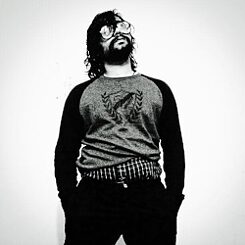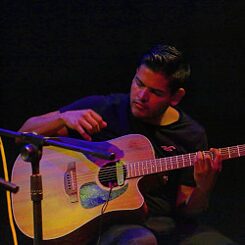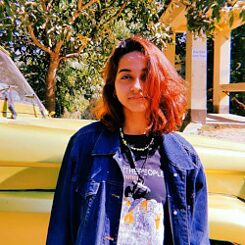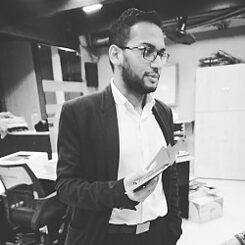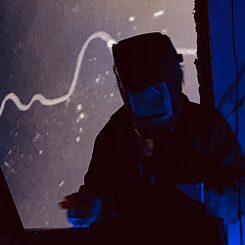Episode 8 – Dhaka
A podcast by BLKBX
Featuring:
Shadwaan Chowdhury
Sounak Das
Muttaki Mahmud
Nazifa Raidah
Technology – The New Normal for Dhaka’s Artists
Episode 8 of the Timezones podcast series, co-initiated and co-produced by Norient and the Goethe-Institut. This episode isproduced by the Bangladeshi artist duo BLKBX and delves into Dhaka’s arts scenes. It features the city’s transformation towards digitization and the ramifications for artists living and working in the metropole.Dhaka serves as the container of 20 million souls – surviving day to day, yet never failing to smile. It’s probably the world’s least known capital, yet it is a melting pot of joy and fear bundled with hope. There’s a lot happening in Dhaka and the sonic arts do not find themselves isolated from these changes. The city’s transformation towards digitization is not necessarily due to a propagandistic portrayal but to the sheer necessity of survival.
Amidst the chaos of navigating everyday challenges for everyday people, the digital world serves as a new form of escape. However, for artists, this dependence can be an impediment – and the creative juices get thrown around in a blender that combines media, art, and technology.
In this episode, Dhaka’s artists speak about their personal motivations and processes in the pursuit of art, knowing the challenges ahead. They shed light on how the pandemic has shaped, or perhaps reshaped, the thought process of making art and how technology can be deemed the new normal for them.
With a growing underground scene for electronic artists, the city is on the verge of its next domino effect that will create a musical revolution, much like its predecessor rock music – one that was by its people and for its people. The artists zoom out from their comfort zone to explore new dimensions fuelled by creativity and discuss how this will change how we perceive and make art.
Chapter 1: The ArtCity
[0:04] Shadwaan ChowdhuryI delved into electronic production [I don’t want to say electronic music, just production], and after I got introduced to ableton, I realized I don’t need anyone else to make music, I can just do it myself. And then, I think I saw an exponential change in my music and it’s just basically me mostly layering percussion acoustically from my acoustic guitar and from that I make different sounds from my other guitars and whatever else I can sample from Ableton.
[0:31] Muttaki Mahmud
My contribution would be opening up 3rd Space (an experimental arts space). A kind of a place where we want to provide a platform for all the arts, and music is a huge part of it. I enjoy the arts and definitely in Dhaka, the art scene and the music scene and everything else is rapidly changing and that is just something that we all can be proud of.
[0:55] Nazifah Raidah
My mom was very keen on making sure that I go into the arts and explore all of it, so she got me admitted to art school. She got me admitted to Chhayanaut (a music school) and I was there for almost eight years. I specialized in Rabindra Sangeet (a genre of classical music penned by the poet and songwriter Rabindranath Tagore). [In Bangladesh, there is a popular saying that there is no future with music, so there is no point in exponentially investing time in this segment]. I got by with a little help from my friends and I’m trying to get back. I’m experimenting and jamming with people that I know I’m meeting new people and learning a lot from them about their processes. And hopefully from this little bit of exposure that I’m getting I’ll be able to conjure more work in the future.
[1:40] Sounak Das
I did my studies on photography, but I am practicing multimedia right now. Multimedia includes photography, video, audio, installation, AR, VR. My father was a theater artist so I have been involved with performance art since my childhood. All these media actually provoked me to actually explore art. My first body of work started with photographing people who actually practiced religion. So from my religion, when my father passed away, I started working on the people who actually go to these temples and they practice religion – the pundits – why they do this, why do they wear this sort of colorful dresses or why do you actually do that kind of lifestyle? [Why?]
[2:25] Nafis Ahmed (BLKBX)
I moved on more into the organizing aspect of things. I started a company called LS that was active in the music scene, but I’m not living in Bangladesh anymore.
Chapter 2: Change as the New Constant
[3:39] Shadwaan ChowdhuryI wish we had an answer to just performing from our homes [together, but one of the biggest problems] is that there’s this huge latency issue.
[3:49] Sounak Das
{You’re not feeling connected.}
[3:52] Shadwaan Chowdhury
I am a very tactile sort of person, if I don’t have stimuli, I don’t really want to work. I actually depend on collaboration. I don’t think I have found my inspiration at all, and that’s why I think my music is very stagnant right now. I wake up one morning, I touch my guitar, sometimes I hear a tune in my head and I try to replicate it. It’s about how a tune makes me feel when I keep on just noodling with the guitar – it’s about how we’re made right and I am a person who has to be stimulated and I think whatever stimulates me inspires me. It’s mostly new songs actually! I think I really rip off every new song I hear. [I tried to write breakup songs but I just can’t!] – I don’t think I can write lyrics.
[4:30] Sounak Das
{He needs to get ditched out every time!}
[4:32] Shadwaan Chowdhury
I guess that’s what all art is, right? You won’t make good art unless you’re hurt! I think I make the best music under influence too [jokingly: there, the other kind of «influences»]. I feel like more restrictions are sometimes more freeing; decision-paralysis is a real thing, right?
[4:47] Nazifah Rajdah
I’m not a person who’s very confident in terms of what I procure. Most of the time I don’t even know what that perfect looks like. It’s been very warm in terms of me figuring out my process as an aspiring songwriter. One of the things that really influenced me is rap, in terms of really heartfelt expression of what rage looks like, what anger looks like, what heartbreak looks like, what suffocation looks like – especially as a person living in Dhaka it almost feels very suffocating every now and then given that there’s a surge of population and problems altogether.
[6:08] Sounak Das
This digitalization was already happening, because when I’m in my own zone right there, the circumference or the radius, is very limited now. Due to this new normal or whatever you say normal, I think it has been practiced by artists lately. We work with a computer, and that’s the only limit we have, right? So, already for practicing artists who work with painting, they completely change into digital; and they don’t work on paper anymore, for example, that’s a new normal for them. Basically (when) I go out, I get influenced by my surroundings and I see what I connect with and that becomes a form of a question of how this confrontation brings to me or reacts inside me. That is one of the new normal that I do not know; if it’s a new normal or is it the normal that I need to adjust with. How do you adopt two different medias together? Because they both have different senses like an image has a vision, you need your vision to sense that; and for sound, I need my audible sensibility to get that – so they both connect to give you a different experience.
[8:09] Muttaki Mahmud
We have these very typical jobs, and then art kind of comes as a side project, or something that you do out of passion. What happens, I think, is that a lot of the things that were the case (are) kind of changing. When we worked with 3rd Space we’ve seen that there are so many people in Dhaka who have so (much) talent, but they definitely have the same problem, that they don’t have a space where they can go and kind of share that. Or, they don’t have the kind of motivation in terms of like the sport whether it be financially or like from the community or even just you know like a place where they can perform. The pandemic has kind of brought that down because it’s a little difficult. Technology in terms of like you know being able to make music on your laptop – to imagine that happening in Dhaka is kind of transformation(al). It’s (kind of) diversifying so I think that there is an opportunity here that you know. Hearing something live is never going to be the same as kind of seeing it through a lens. {Garbled audio} Making something – be it music or be it art, takes a holistic experience. You need to work with someone, and when you work with someone, you can definitely work with them online but it’s not the same as sitting together and getting a track out. There’s definitely going to be an adjustment especially with us in 3rd Space, we think that big concerts might not be the future anymore. It might be a more intimate kind of gatherings, (and) that’s something that would be more socially responsible where you have like very intimate settings where you can kind of get the feel of the experience that you have. I definitely think you know this is not gonna be there’s never gonna be a {replacement for being able to enjoy a show in person}.
Chapter 3: Technology in Art in Technology
[10:40] Sounak Das{You see that this revolution of technology that we are talking about} even if you think of the experience or the culture of a walkman – it was the new normal. And you see the transformation of a walkman becomes just nothing – you can have wi-fi in your headphones and you can just listen to music. So I was actually interested to know – is it our practice (that) should be something that how we converse (transverse) this experience from physical to digital/virtual/complex period of time that we are going through. Is it a challenge? How do you convey that experience like the tactile feeling of having experienced something through technology, because I guess technology is the new normal. We are not going through the new normal, we are just getting adjusted to that. We are actually all using software to create something of an experience. A photographer making an image and there is less light there, you would always brush this to brighten this up this would go for a sound this would go for anything you’re working with any medium. Even if you’re working with a sculpture, if something gets white you would always color that black even with a marker you have. My question is how to actually convey this digitally?
[11:57] Nazifah Raidah
An article in Bloomberg titled «the new normal is probably here and the new normal is never going to happen», the assumption was (that) we will just build herd immunity towards it and that’s the only way we’re going to survive. That is the primary hypothesis. [The other hypothesis is that] the fourth industrial revolution [which we have entered] – a situation where you can’t really meet, does that mean that the art itself is going to get blocked off? [For] auditory experiences, there is enough technology out there to give you the closest real-life experience of having those crisp sounds. However, [now for the] physical simulation {there needs to be new technologies that can replicate concerts}. (We have to) normalize the idea that there’s going to be online concerts, and not devaluing the fact that someone’s actually spending their time, and just because it’s online it doesn’t mean it’s a real concert – it’s sort of the secondary (activity) that keeps the art of performing alive.
[12:56] Nafis Ahmed (BLKBX)
I’m practicing with some experimental cross-media ideas...
[14:23] Sounak Das
(Everyone is technocentric!) The pattern is different – I cannot install. I just need to make animation or you know audio visual to present something, or else I cannot do anything. So that limitation is what that the musicians or the producers are going through, because that’s a big challenge? [Why are we not able to express this from within ourselves?]. Everyone is technocentric! [I am trying to say that if my practice becomes technocentric], then is it my responsibility or is it our responsibility to actually question the new normal, rather than being questioned. As a photographer, I’m using equipment to make photographs, and that becomes art. So my art practice is (using) the camera, computer, mouse, and print. So everything is techno-centric, you see? So people working with color and paper have turned into digital tabs. Where is the emotion going then? We are not able to express that, because we are all within these bombardments.
Chapter 4: Access is Ability
[16:01] Sounak DasIf you say one is an engineer, they would specify a particular point they are interested in. So that’s how technology has given us the opportunity to explore more, but materials always existed. I guess we already had materials but we wanted to explore how these materials can connect with something else – the wireframe! When the binary is affected, binary [though] it’s a different form of pattern – quantum, suppose, and that not that is not how the brain. [So my question is that if the brain doesn’t function like that, and it interacts with me, is it the new normal, or am I (going through) the new normal? I am making it, and that object is controlling me.]
[16:40] Nazifah Raidah
... It makes you question what we consider authentic in music. If we ask ourselves «What is music?», we don’t have a constructive answer. You can’t necessarily put it into a box and say, «okay, that is what it looks like». So I think particularly the point about, «Oh, does it own us?» – I don’t think it owns us as per se, it can also be considered accessible to someone and it basically lets you skip over 10 steps that someone else had to go through. In a lot of conversations, angsty rock musicians are coming up and saying «Oh, these are not real musicians!». If I do consider the fact that inspiration can happen from anywhere – it can come from a blender even. To make it seem to someone that «Oh, I like that sound, that sound is new». [If someone can trigger this, I don’t think the question of ownership becomes an important issue. The understanding of what goes well with what, that in itself is an originality coming from the artist] even though major ownership of how the music was produced happened through technology and ethnocentrism (that you talked about). Technology, music and innovation can go hand-in-hand and (that is) how you can basically transcend boundaries.
[17:52] Sounak Das
That’s what Ableton (referring to Robert Henke, co-founder of Ableton) did. He made Ableton because he was not able to produce any more music, because the music he wanted to make, he was not able to produce it. So he designed software so that he could create, so that’s what I’m asking. I don’t believe that it’s easy, it’s an emotion and we need a medium or we have skills but we need a particular platform to express that skill.
[18:15] Nafis Ahmed (BLKBX)
Because of technology, a lot of things are coming together. We used to see audio very separate from everything else. [Then say that in the 2000 era, the visual component came into the picture, before that it was lights]. And these technologies are literally home production technologies (where) all these mediums can talk to each other and new things are also coming up. [One thing can be that these are] new mediums of expression! [But the whole idea about 20 years back], the human-driven aspect would have been very difficult to do, because a lot of the job is done by technology as an enabler, because humans [that is beyond our scope] – even hundreds of them practicing thousands of times (couldn’t produce these expressions)!
[18:58] Sounak Das
{If I am told to perform the same sound hundreds of time, I would still mess up}
[19:02] Nafis Ahmed (BLKBX)
{The expression would kill you!}
[19:08] Sounak Das
{Art is electricity, man!}
[19:41] Ananda (BLKBX)
... but I think we need to have a balance between technology, physicality, mentality, and spirituality.
[19:47] Sounak Das
{Without science, religion wouldn’t exist. And without religion, science doesn’t exist}
[19:52] Nafis Ahmed (BLKBX)
It’s a conflict, but also complementary.
[19:55] Ananda (BLKBX)
In actual reality we see something as a paradox, because of our limited senses.
[20:01] Sounak Das
{[Didn’t Plato say this in The allegory of the cave?}]
Chapter 5: Back to the future
[20:05] Sounak DasYounger people with skill who are experimental and who experiment should have more opportunities than people who are already practicing. That’s when you see something very new. What we lack is in connection, and in highlight, you can say promotion. There are a lot of skillful people, but we don’t know them just because they don’t have a platform to share something.
[20:28] Shadwaan Chowdhury
(Successful) people think that people from the bottom are just trying to claw their way to the top and they’re trying to bring down people on the top, and that idea is toxic. And that’s actually not even the real case, because this country is a big place with a huge population, and I think opportunity isn't given. It’s just actually rigged – old(er) artists just get way-way-way more priority!
[20:55] Sounak Das
There should be platforms where you comment about art only. [Someone may not appreciate my work], but that conversation can give me another idea to make the same thing (with a different perspective) which connects with that person. If you’re making music you’re not always targeting people, you’re always trying to self-satisfy yourself at the first point.
[21:12] Shadwaan Chowdhury
We can emotionlessly just make some (sh*t) and the thing is that it won’t reverberate with anyone, not even yourself.
[21:20] Sounak Das
You’re not able to connect with that particular noise because you haven’t experienced that noise in your life. [If someone does not sit inside a generator room for a half hour], he doesn’t know how does a generator feel like, but that’s an experience I go through [when the electricity goes off in Bangladesh and people are surrounded by that sound of the generator room] and that’s an experience, you know? So, I’m talking about a glitch here. [The fact that there will be lags and latency in music compositions] – for me this is completely true.
[21:44] Ananda (BLKBX)
That’s like digital awkwardness, [the] glitch, the pixelations – that makes digital art human.
[22:13] Nazifah Raidah
[In Bangladesh, there’s a lot of folk (instruments) that are fading away rapidly from our cultures, because of the lack of performers. Each area has distinguishable sounds, and they have their own (traditional) music, and they also have their traditional instruments – neither are we nurturing this heritage, nor are we practicing them. We are not even thinking about conserving them despite these cultures being on the verge of extinction.]
{After not having record labels or agents, which only means that we are the cockroaches who can survive.}
[23:49] Nafis Ahmed (BLKBX)
{The critical mass doesn’t exist, and suddenly we have a new sound, and that becomes a huge movement in itself. The moment there’s some level of patronization that the art gets, say some corporate or funders and the scene itself.}
[If a listener base can be created], there’s a huge (potential) – they’ll drive it. Then commercial interest will also start to peak. [So far] particularly in the field of experimental (or) electronic art, overall [this interest hasn’t garnered yet in this sector], but I think everyone’s working towards it.
[24:29] Nazifah Raidah
Look at this as a situation where yes because there are barren lands probably it’s time to you know sow our crops!
[24:37] Sounak Das
It should be experimental and more open, you know, it should be open to anyone.
[24:43] Muttaki Mahmud
Be brave and take chances.
[24:46] Shadwaan Chowdhury
Interact.
[24:47] Nazifah Raidah
Think outside the box.
[24:48] Nafis Ahmed (BLKBX)
Be collaborative.
[24:50] Sounak Das
Everyone should, enjoy.
Sounak Das is a multimedia artist based Dhaka, Bangladesh; predominantly using photography, moving images, sound, and installation. His practice renders ideas along the omnipresent lingering landscapes and aspects of urban scenarios, with minimal representations of the convenient elements of time.
Shadwaan Chowdhury is a guitarist and producer from Dhaka working with Ableton Live looping.
Nazifa Raidah is a music enthusiast who dreams of a Bangladesh with a booming music industry. She’s a writer with a distinguished background in Rabindra Sangeet, ready to take on the world of the unknown.
Muttaki Mahmud is the founder of 3rd Space, an open-for-all platform dedicated to promoting arts and culture in Dhaka.
Shadwaan Chowdhury is a guitarist and producer from Dhaka working with Ableton Live looping.
Nazifa Raidah is a music enthusiast who dreams of a Bangladesh with a booming music industry. She’s a writer with a distinguished background in Rabindra Sangeet, ready to take on the world of the unknown.
Muttaki Mahmud is the founder of 3rd Space, an open-for-all platform dedicated to promoting arts and culture in Dhaka.
BLKBX is an experimental audiovisual endeavour aiming to enable artists and curators from different walks of life to come together and venture into new worlds of creative ideas.
Follow BLKBX on Instagram.
Contact: nafisislive@gmail.com
Follow BLKBX on Instagram.
Contact: nafisislive@gmail.com
Credits
Artistic Editor: Suvani Suri
Project Management: Hannes Liechti
Video Trailer: Emma Nzioka
Jingle Voiceover: Nana Akosua Hanson
Jingle Mix: Daniel Jakob
Mastering: Adi Flück, Centraldubs
Artwork: Šejma Fere

